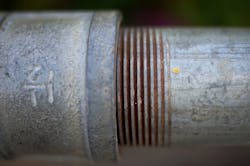AWWA Board supports recommendation for complete removal of lead service lines
DENVER, CO — MThe Board of the American Water Works Association voted unanimously Monday to support recommendations from the National Drinking Water Advisory Council (NDWAC) that strengthen the Lead and Copper Rule and ultimately lead to the complete removal of lead service lines.
“The water community’s first priority is to provide safe water for everyone,” said AWWA CEO David LaFrance. “The AWWA board’s support for the NDWAC recommendations underscores the importance of protecting families today from lead exposure and a shared responsibility among utilities, customers, property owners and government for the complete removal of lead service lines over time.”
The 15-member NDWAC advises the U.S. Environmental Protection Agency on matters related to drinking water. It includes members of the general public, state and local agencies, and advocacy groups concerned with safe drinking water and public health. Before the lead situation in Flint, Michigan, was widely reported, EPA was already in the process of revising the Lead and Copper Rule, with the new proposed rule likely coming in 2017.
Among the NDWAC’S Dec. 15 key recommendations are that water utilities:
1. Locate and replace all lead service lines completely, sharing responsibility for that replacement with customers,
2. Conduct additional monitoring and analysis of water quality parameters in order to better manage corrosion control,
3. Expand on current educational outreach to alert customers, particularly customers with lead service lines, to the risks posed by lead and steps they can take to reduce those risks, and
4. Analyze customer-samples for lead upon request.
“Communities have taken positive steps for more than two decades to reduce lead exposure from water and other sources,” LaFrance said. “But there is clearly much more to be done. The Flint crisis lays bare a simple fact: As long as there are lead pipes in the ground or lead plumbing in homes, some risk remains. As a society, we should seize this moment of increased awareness about lead risks to develop solutions for getting the lead out.
“Part of this discussion must focus on affordability for customers,” LaFrance added. “There may be opportunities to learn from existing government assistance programs that address other sources of exposure such as lead paint and dust.”
Lead is unlike other potential contaminants in that it is rarely present in the water coming from treatment plants and water mains; rather it comes from lead service lines and home plumbing. Under the Lead and Copper Rule, utilities collect samples from homes thought to be at high risk for lead. They use results from those samples to indicate if the utility should adjust water chemistry to protect against lead leaching into the water.
In forwarding recommendations to EPA Administrator Gina McCarthy, NDWAC Chair Jill Jonas noted that full lead service line replacement will require “significant financial resources and time. During this time it is essential to have in place a robust effort of consumer education and engagement to assure ongoing protection from exposure to lead in drinking water,” she wrote.
A study to be published this week by the American Water Works Association estimates 6.1 million lead service lines remain in U.S. communities today.
